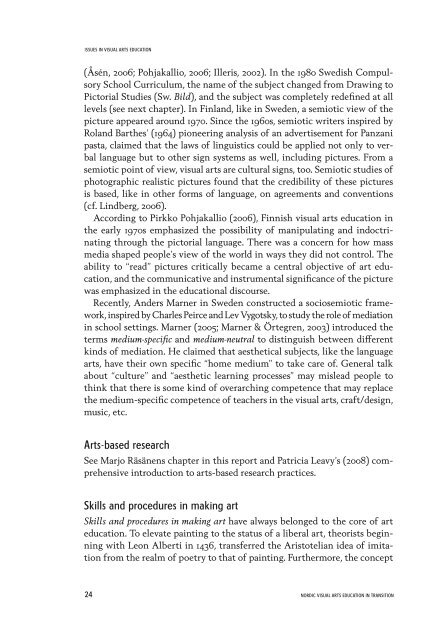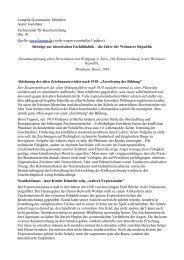Research in Visual Arts Education - The National Society for ...
Research in Visual Arts Education - The National Society for ...
Research in Visual Arts Education - The National Society for ...
Create successful ePaper yourself
Turn your PDF publications into a flip-book with our unique Google optimized e-Paper software.
ISSUES IN VISUAL ARTS EDUCATION<br />
(Åsén, 2006; Pohjakallio, 2006; Illeris, 2002). In the 1980 Swedish Compulsory<br />
School Curriculum, the name of the subject changed from Draw<strong>in</strong>g to<br />
Pictorial Studies (Sw. Bild), and the subject was completely redef<strong>in</strong>ed at all<br />
levels (see next chapter). In F<strong>in</strong>land, like <strong>in</strong> Sweden, a semiotic view of the<br />
picture appeared around 1970. S<strong>in</strong>ce the 1960s, semiotic writers <strong>in</strong>spired by<br />
Roland Barthes’ (1964) pioneer<strong>in</strong>g analysis of an advertisement <strong>for</strong> Panzani<br />
pasta, claimed that the laws of l<strong>in</strong>guistics could be applied not only to verbal<br />
language but to other sign systems as well, <strong>in</strong>clud<strong>in</strong>g pictures. From a<br />
semiotic po<strong>in</strong>t of view, visual arts are cultural signs, too. Semiotic studies of<br />
photographic realistic pictures found that the credibility of these pictures<br />
is based, like <strong>in</strong> other <strong>for</strong>ms of language, on agreements and conventions<br />
(cf. L<strong>in</strong>dberg, 2006).<br />
Accord<strong>in</strong>g to Pirkko Pohjakallio (2006), F<strong>in</strong>nish visual arts education <strong>in</strong><br />
the early 1970s emphasized the possibility of manipulat<strong>in</strong>g and <strong>in</strong>doctr<strong>in</strong>at<strong>in</strong>g<br />
through the pictorial language. <strong>The</strong>re was a concern <strong>for</strong> how mass<br />
media shaped people’s view of the world <strong>in</strong> ways they did not control. <strong>The</strong><br />
ability to “read” pictures critically became a central objective of art education,<br />
and the communicative and <strong>in</strong>strumental significance of the picture<br />
was emphasized <strong>in</strong> the educational discourse.<br />
Recently, Anders Marner <strong>in</strong> Sweden constructed a sociosemiotic framework,<br />
<strong>in</strong>spired by Charles Peirce and Lev Vygotsky, to study the role of medi ation<br />
<strong>in</strong> school sett<strong>in</strong>gs. Marner (2005; Marner & Örtegren, 2003) <strong>in</strong>troduced the<br />
terms medium-specific and medium-neutral to dist<strong>in</strong>guish between different<br />
k<strong>in</strong>ds of mediation. He claimed that aesthetical subjects, like the language<br />
arts, have their own specific “home medium” to take care of. General talk<br />
about “culture” and “aesthetic learn<strong>in</strong>g processes” may mislead people to<br />
th<strong>in</strong>k that there is some k<strong>in</strong>d of overarch<strong>in</strong>g competence that may replace<br />
the medium-specific competence of teachers <strong>in</strong> the visual arts, craft/design,<br />
music, etc.<br />
<strong>Arts</strong>-based research<br />
See Marjo Räsänens chapter <strong>in</strong> this report and Patricia Leavy’s (2008) comprehensive<br />
<strong>in</strong>troduction to arts-based research practices.<br />
Skills and procedures <strong>in</strong> mak<strong>in</strong>g art<br />
Skills and procedures <strong>in</strong> mak<strong>in</strong>g art have always belonged to the core of art<br />
education. To elevate pa<strong>in</strong>t<strong>in</strong>g to the status of a liberal art, theorists beg<strong>in</strong>n<strong>in</strong>g<br />
with Leon Alberti <strong>in</strong> 1436, transferred the Aristotelian idea of imitation<br />
from the realm of poetry to that of pa<strong>in</strong>t<strong>in</strong>g. Furthermore, the concept<br />
24 NORDIC VISUAL ARTS EDUCATION IN TRANSITION



